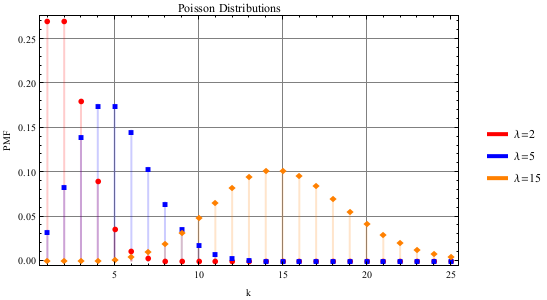Innoslate Functional Model Execution with Discrete Event and Monte Carlo Simulators
Introduction to executing an Action or Activity Diagram.

In the Action or Activity Diagram, Innoslate provides powerful capabilities for executing functional models through its advanced simulation tools, specifically the Discrete Event Simulator and the Monte Carlo Simulator. These tools enable users to analyze complex systems by simulating the behavior of various components over time, allowing for a deeper understanding of how different actions and events interact within a modeled environment.
Creating a functional model in Innoslate involves organizing Action Constructs that embody various tasks and processes. This arrangement establishes the sequence of actions while integrating dynamic components through scripting and statistical distributions. Scripting enables users to tailor the model's behavior, introducing logic and variability that mirror real-world situations. Meanwhile, distributions improve precision by producing random values that account for inherent uncertainties.
In the following sections, we will explore the foundational steps for building a functional model, focusing on how to leverage the scripting options and distribution functionalities available within these diagrams. This will empower you to create more robust simulations that yield insightful results, ultimately aiding in decision-making and strategic planning.
| Scripting | Scripting overview for functional modeling. |
| Distributions | An overview of the distributions supported in Innoslate. |
Introduction to Scripting Options
When selected, all Action Constructs in both the Activity or Action Diagrams have a 'Script' button appear on the top of the Toolbar Frame.
 This 'Script' button is a pop up to allow users to add JavaScript into their models for execution in the Simulator. This Script field is available for all Action constructs.
This 'Script' button is a pop up to allow users to add JavaScript into their models for execution in the Simulator. This Script field is available for all Action constructs.

Depending on the specific type of Action construct selected, this popup can change to reflect options for that specific construct. Below we will cover these options provided per construct.
Loop Construct

The Script pop up for a Loop action defaults to the Iterations option. Here, users can select how many times to iterate the actions in the loop.

Note, the Loop Iterations field (circled in red above) is a dropdown and more options are provided to modify the behavior of the loop in the model. These options are shown below.

If Loop Probability is selected, the pop up will be changed to reflect percentage fields for users to select the probability of the loop continuing or exiting, as shown below. 50% is the default option for both options. Users may enter or use the selector that appears on the right by the percentage sign to enter their desired percentage.

A Loop Action can also be dependent on Resources. Once the Loop Resource option is selected, the Resource must be selected on the second dropdown, as shown in the image below.

Once a Resource is selected, users will have to select the operator type, to continue the loop, based on the amount on the field on the right of the Continue Condition Dropdown. Operator Types included are Greater Than or Equal to, Greater Than, Less Than or Equal To, Less Than, or Equal To.

Underneath all these GUI options, is the JavaScript which is shown below, for 30 iterations. Not only will the 'Script' option reflect any of the options discussed above, but is also available for further editing to execute the model, by selecting 'Edit Script.'

OR Construct Script Options

The OR Construct's Script pop up defaults to the Probability option as shown above (if more branches are add the pop up will reflect the amount of branches available). Since the specific construct is an OR action, users may select how often, based off of a percentage, to go on to a particular branch. The Or construct can also be based off of a Resource, as shown below.

When the 'Or Resource' option is selected, the pop up will provide a second dropdown field to allow users to select a specific resource for the action to be dependent on.

Once this is selected, users may select the conditions of the resource for each branch.

The conditions that can be set for each branch are shown below. They are Greater Than or Equal to, Greater Than, Less Than or Equal To, Less Than, Equal To, or Else.

Distributions
Distributions are vital in making a computer model more accurately represent a real-world system. Innoslate natively supports eight continuous distributions (Beta, Exponential, Gamma, Log-Normal, Normal, Triangular, Uniform, and Weibull) and two discrete distributions (Binomial and Poisson). Any of these distributions can be used in place of a simple value in any attribute of an entity or relationship which is of the data type 'Number' in your project’s database schema.
During a simulation run, Innoslate will use the distribution on an attribute to generate a random number for that attribute that falls within the bounds of the distribution. For example, when using a Uniform distribution where a = 15 and b = 20, the simulator could return a value of 16.835 in the first simulation run and a value of 19.015 in the second simulation run.
Adding a Distribution
To apply distributions to attributes like a Duration in an Action class or the Initial, Minimum, or Maximum Amount of a Resource, simply begin by typing an "=" sign. This will prompt a drop-down menu to appear, showcasing the supported distributions that you can choose from. If you are using a non-US-Eng keyboard layout, the "=" shortcut may not work for you. These users will want to switch the keyboard format to US-Eng (if available) to utilize distributions.
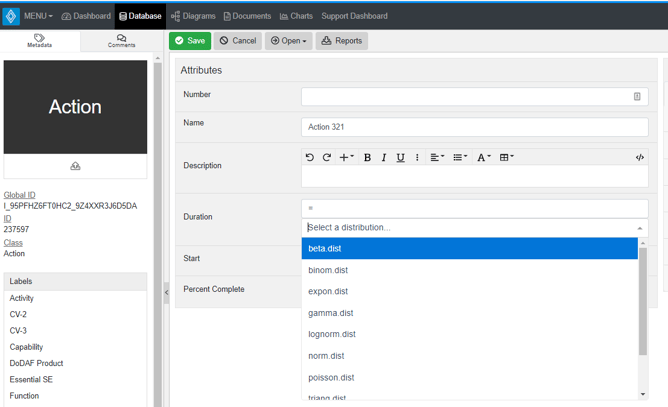
More information on each of the supported distributions including parameters and common uses can be found below.
Continuous Distributions
Each distribution has a plot of the distribution with multiple parameter options shown. The plot has an x value along the horizontal axis and the associated Probability Density Function (PDF) along the vertical axis. A higher PDF implies there will be a larger concentration of random numbers which fall within a given x range. Information on calculating the probability of a random number falling within a given range can be found at: http://en.wikipedia.org/wiki/Probability_density_function
During simulation Innoslate will return a random real value, x, such that a set of the values when plotted as a histogram will produce a shape nearing the shape of the distribution.
Beta Distribution
The Beta distribution is useful for generating a continuous random distribution between the fixed bounds of 0 and 1. The Beta distribution is best for predicting probabilities, calculating failure rates, or time allocation. For more information, see http://en.wikipedia.org/wiki/Beta_distribution.
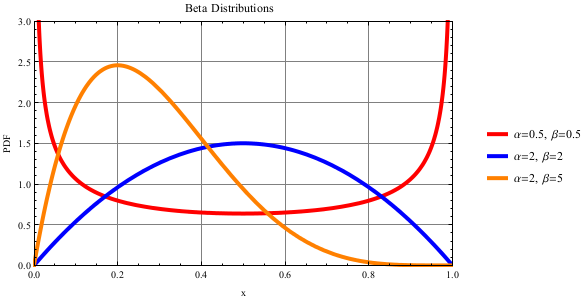
Exponential Distribution
The Exponential distribution describes the time intervals between a Poisson process. The return value, x, returns the next random interval between Poisson events. The Exponential distribution is best for describing the time between customer arrivals, service times, or time until the next particle decay. For more information, see http://en.wikipedia.org/wiki/Exponential_distribution.
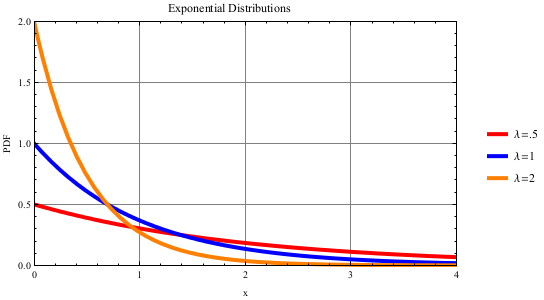
Gamma Distribution
The Gamma distribution has many different uses including modeling the time required for k events to occur in a Poisson process, modeling waiting times, or resource consumption. For more information, see http://en.wikipedia.org/wiki/Gamma_distribution.
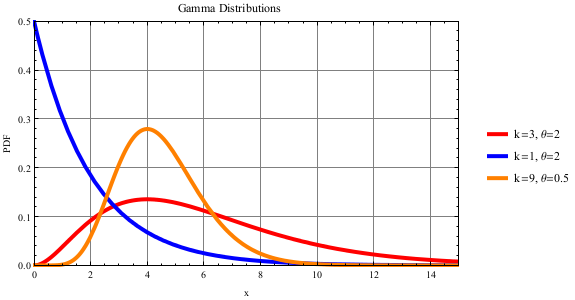
Note the Gamma distribution has two common formats. Innoslate uses the format of Gamma(k, θ) where k is the shape and θ is the scale. The second format is Gamma(α, β) where α is the shape and β is the rate. This second format can be transformed into the first format using the following equations: k = α, θ = 1/β
Log-Normal Distribution
The Log-Normal distribution generates a number equal to eN(μ, σ), where N(μ, σ) is a Normal distribution. The Log-normal distribution is best for describing the volume of gas in a reserve, incubation periods, or system repair time. For more information, see http://en.wikipedia.org/wiki/Log-normal_distribution.
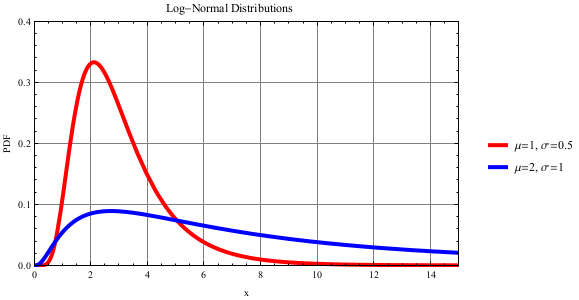
Normal Distribution
The Normal distribution returns a value that will 95% of the time fall within 2 standard deviations (σ) of the mean (μ). This distribution is best for modeling natural processes, task completion time, or randomness of characteristics. For more information, see http://en.wikipedia.org/wiki/Normal_distribution.

Triangular Distribution
The Triangular distribution is best used when a minimum, maximum, and most likely outcome are known; providing basic randomness; or early estimation of task completion time. For more information, see http://en.wikipedia.org/wiki/Triangular_distribution.
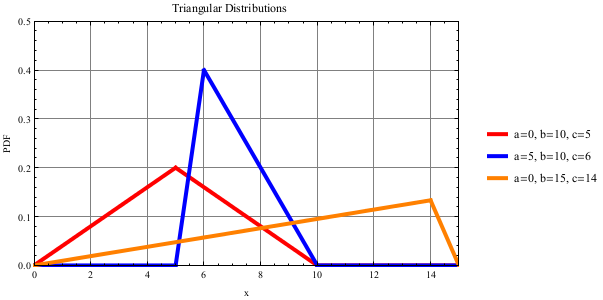
Uniform Distribution
The Uniform distribution is commonly used in risk analysis, to calculate an unknown wait time, or randomly choose a selection in a set. For more information, see http://en.wikipedia.org/wiki/Uniform_distribution_(continuous).
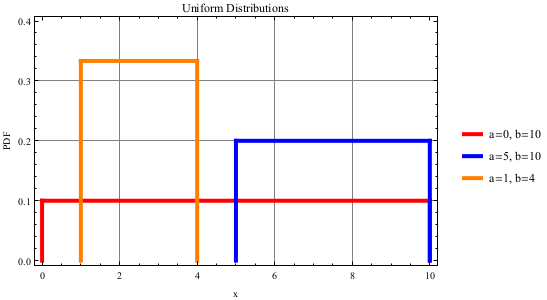
Weibull Distribution
The Weibull distribution is a very versatile distribution, with the ability to be right-skewed, left-skewed, or symmetric. Due to this ability, the Weibull distribution is often used to model component reliability or characteristics, an increase or decrease in capability, or a system’s lifetime. For more information, see http://en.wikipedia.org/wiki/Weibull_distribution.
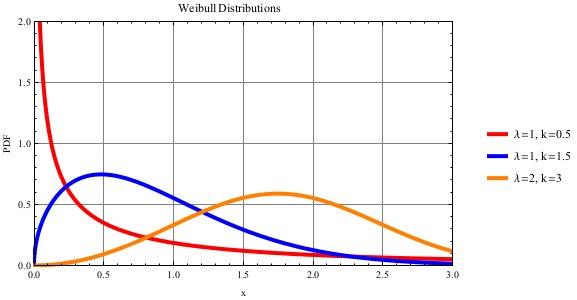
Discrete Distributions
Each distribution has a plot of the distribution with multiple parameter options shown. The plot has a k value along the horizontal axis and the associated Probability Mass Function (PMF) along the vertical axis. A higher PMF implies there will be a larger concentration of random numbers which fall on a specific value. Information on calculating the probability of a random number falling within a given range can be found at: http://en.wikipedia.org/wiki/Probability_mass_function
During simulation Innoslate will return a random whole value, k, such that a set of the values when plotted as a bar graph will produce a shape nearing the shape of the distribution.
Binomial Distribution
The Binomial distribution models the number of successes from n independent trials where there is the same probability p of success in each trial. The Binomial distribution is best for counting the number of part failures based on n attempts, the number of failures generated from a repeated process, or the number of successful transmissions between wireless devices. For more information, see http://en.wikipedia.org/wiki/Binomial_distribution.
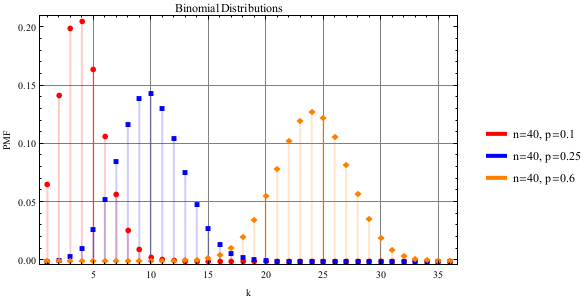
Poisson Distribution
The Poisson distribution models the number of events occurring over an interval of time, where λ is the mean number of events in that interval. Common uses of the Poisson distribution include counting the number of arrivals per day, ideal vehicle distance in traffic flow, or counting the number of resources needed to be consumed. For more information, see http://en.wikipedia.org/wiki/Poisson_distribution.
